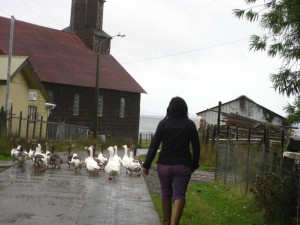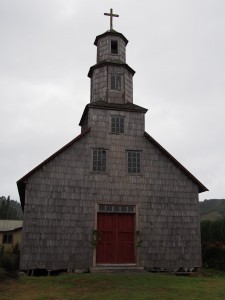When we started discussing the idea of taking this trip, one of many appealing prospects was the idea that we could travel slowly. Rather than hopping in to a new place for a day to see the highlights and leaving again with little memory of what we saw and some photos of unknown monuments and churches, we would have time to relax and get to know the places we visited. On the whole, we’ve tried to do this, but one of the main problems with this approach is that we also hate the idea of missing things. Obviously it’s impossible to see everything, but with more than a month in Chile, for example, we feel (entirely self-imposed) pressure to experience the highlights that most appeal to us. I recognize that these are pretty good problems to have.
All of this is to say that occasionally, we will no doubt be doing a lighting-fast visit to one place or another, and our overnight visit to Chiloé island is one example. It is a strange and intriguing place. Isolated from the mainland, Chilotes developed a distinct culture, including a hybridized mythology combining legends and beliefs of the indigenous inhabitants with those of the Spanish conquistadors who showed up in the 1500s. It features ghost ships, basilisks, witches, warlocks, mermaids, giant horses, and maiden-stealing dwarfs. Definitely worth a visit.
We rented a car in Puerto Varas, and after a few hours’ drive and a short ferry ride, arrived in Ancud, one of the two main towns on the island. We spent the day driving around (and eating, naturally) and despite the rainy weather, we managed to experience the highlights and get a bit of a feel for the place before returning our car in Puerto Montt the following day and flying down to Punta Arenas.
Chiloé is probably best known for the seaside wooden churches that dot the island– there are more than 100, and quite a few have been designated as UNESCO World Heritage Sites. There are a number of other scenic attractions, including Palafitos, colorful fisherman’s shacks supported by stilts and lining the water’s edge in the town of Castro and beautiful rolling hills, and the like. Of significant importance to us as we eat our way across the continent, it is the best place in Chile to try curanto, a stew of seafood, meat, and dumplings that is traditionally cooked in the ground for more than a day.

Unrelated to anything, but this woman was herding geese down the street remarkably effectively and it seemed a shame not to document it
Side note from Brian: When we arrived in Ancud (one of the larger towns in Chiloe, and the town in which we were staying), we found a spot for lunch called Kuranton, known for its curanto. We’d experienced curanto before but nothing like this. The portion was huge (typical for Chile… this country gets me)– it was a large bowl filled with mussels, clams, pork, chicken, sausage, dumplings and potatoes. A side bowl was soon brought out which contained the broth. Our waiter–an older gentleman–noted with a grin that the broth was “liquid viagra.” The clams and mussels were enormous. The mussels in particular–which were “green lipped” mussels, which I guess is a thing… not in Wyoming but elsewhere–were particularly intimidating. Normally when I eat mussels, I focus on the broth. The mussel itself can be swallowed without much thought (and without much chewing). Truth be told, I think mussels are pretty freaky looking things so I try to dispense with them without much ceremony. When confronted by a super-sized mussel, I was, to say the least, intimidated. However, part of this trip is experiencing things outside of my comfort zone, including food. The problem is that the mussels were too big for a single bite, so I had to either take a huge bite and chew it, or cut it up on the plate. Not wanting to prolong the experience, I took the huge bite, chewed as quickly as possible, and swallowed. Totally worth it. [Side response from the wife– wait until we get to Peru, where they eat 65 million guinea pigs per year…yikes]



Biggest takeaway from this post: we need more asides from Brian. Once you get over the fact that you’re eating a routinely domesticated animal in the U.S., the guinea pigs are actually pretty tasty! When you get to Cuzco, be sure to eat at Pachapapa. Also, your blog has somehow made its way on to my Google Now, so I’m immediately made aware of updates, as if you needed reinforcement of your general world importance.
J — your wish is our command. Newest post is B’s! I don’t know what this google now nonsense is…you kids and your technology.